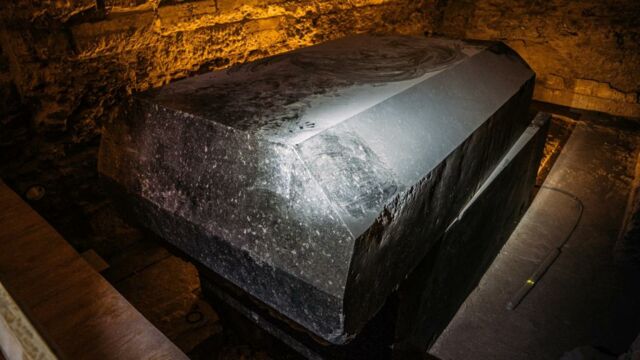A mysterious black sarcophagus has been opened

Egyptian archaeologists unearthed a mysterious sarcophagus that was buried underground for more than 2,000 years.
Discovered purely by chance, this antique coffin is surprising because of its unusual size, but also because of its exceptional state of preservation, which promises to reveal even more secrets. On July 19th, despite warnings of a possible 'curse,' the sarcophagus was opened.
Discover our latest podcast
Six feet tall, eight and a half feet long and five and a half feet wide are the dimensions of this enigma. This mystery made of black granite was buried sixteen feet underground in Alexandria, the ancient Egyptian capital built west of the Nile delta. According to the archaeologists, the only thing that is certain so far is that this block of stone is indeed a sarcophagus.
More under this adMore under this adThe discovery was announced by the Egyptian Ministry of Antiquities. In a message posted on social media, officials in the organisation unveiled the circumstances around the discovery. They said:
An Egyptian archaeological mission conducted by the Supreme Council of Egyptian Antiquities has unearthed an ancient tomb that dates back to the Ptolemaic period.More under this adMore under this ad
The Ptolemaic period was more than 2,000 years ago!
The burial site appeared ‘during excavation work carried out to inspect the land of a resident of Alexandria, while digging around the foundations of his building in Al-Karmili Street, in the Sidi Gaber neighbourhood,’ says Dr. Mostafa Waziri, Secretary General of the Supreme Council of Egyptian Antiquities.
A perfectly intact sarcophagus
A particular detail of this unusual object has aroused the interest of specialists. The mortar seal, affixed to keep the cover of the sarcophagus in place, still seemed perfectly intact. The tomb in which it had been discovered had therefore remained untouched for more than 2,000 years, a rarity in a region that has been ravaged by looting for several centuries.
More under this adMore under this adAnother major discovery made around this mysterious ebony sarcophagus is an equally enigmatic alabaster bust. Although its features have been rendered unrecognisable due to weather erosion, specialists believe that it could very possibly represent the owner of the tomb. The bust’s identity remains a mystery for the moment but the details suggest that it could be a high dignitary of ancient Egypt.
Secrets to be revealed
The area, which following the excavation has become an important location in Egyptian archaeology, is now under guard. Dating from a period between 304 and 30 BCE, this tomb was built after the death of Alexander the Great, former king of Macedonia, who died in 323 BCE.
More under this adMore under this adArchaeologists hope to discover the identity of the deceased resting in this mysterious sarcophagus as soon as possible. Not only do they wish to uncover their name but also any possible jewels or other precious objects placed with the dead to accompany him on his journey to the afterlife. The final element intriguing specialists is the size of the sarcophagus. Its unusual dimensions certainly promised more discoveries just as exceptional as the sarcophagus itself.
Opening the sarcophagus
Whilst it was expected that archaeologists would use X-rays to discover the sarcophagus’ secrets, without even having to open it, the sarcophagus was indeed opened on July 19th.
More under this adMore under this adSome had hoped that the coffin might contain the remains of Alexander the Great, whilst others feared a deadly curse. On opening the sarcophagus, experts found three skeletons– and a lot of reddish-brown sewage water. In fact, the stench was so pungent that the first opening of the coffin had to be abandoned and military engineers were called to help with the subsequent opening.
Experts believe the three skeletons may have been a family of soldiers from the time of the Pharaohs. One of the skulls appears to show a crack consistent with an injury caused by an arrow.
More under this adMore under this adInvestigations will continue in order to discover more about the sarcophagus but whatever they find, this is clearly a new and exciting treasure that will be added to the continuously growing list of innumerable ancient wonders discovered in the land of the Pharaohs.